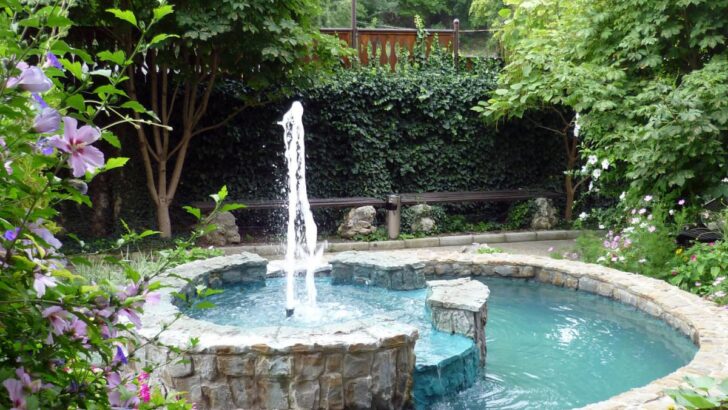Adding a water feature to your yard or garden can give you endless hours of delight. Water fountains and the landscaping around water fountains can become the visual focus of your landscape, and a vital source of water for birds, bees, butterflies, and other wildlife.
Moving water is more attractive than still water for nature’s creatures that will visit your fountain. Motion deters the growth of algae. The sound of moving water is attractive to the wildlife that will visit your fountain – and soothing for you, inviting you to spend more and more time in your backyard paradise.
But what are the right plants for landscaping around water fountains?
The honest answer to these questions is “It depends.”
Your choice of landscaping around water fountains is informed by the type of water fountain you choose as your water feature, and where you place it in your landscape.
Choosing the Site for Your Water Fountain
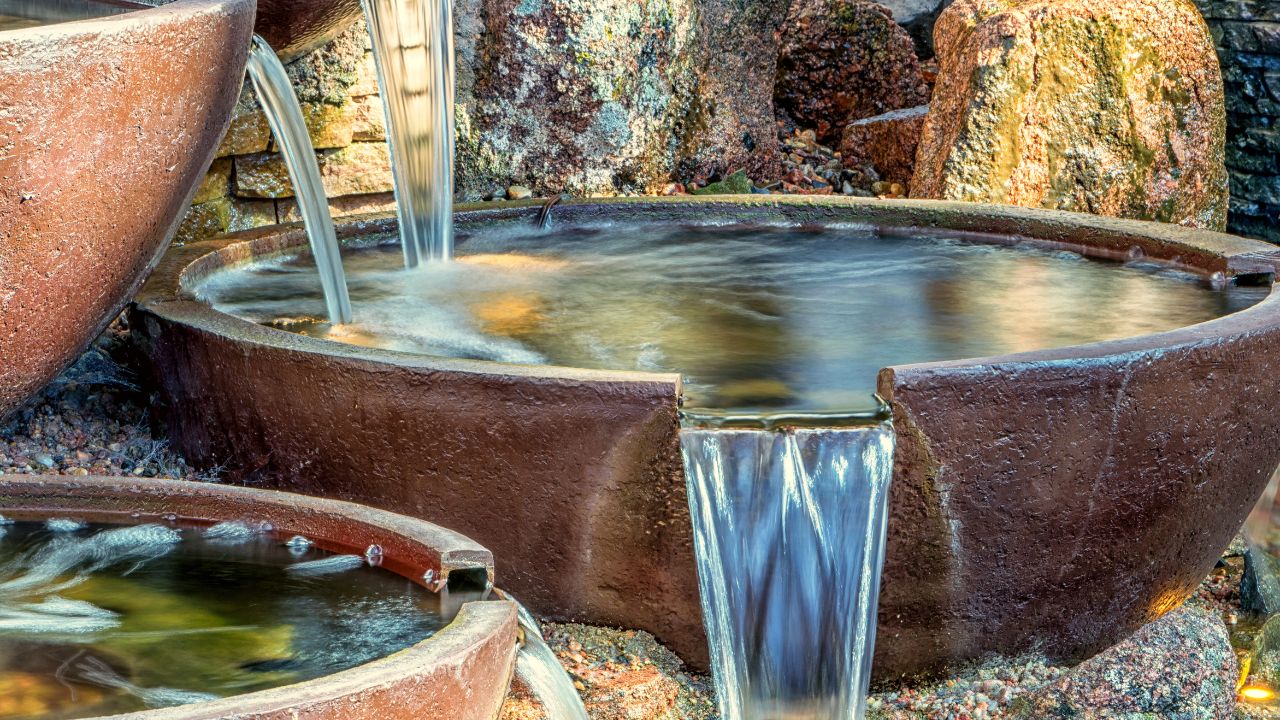
Image Credit: Shutterstock.
The first choice you will need to make is where you will put your water fountain. One way to look at site selection is as a choice between choosing a water fountain to accent your landscape or changing your landscape plants to accent your water fountain.
Lifestyle choices inform landscaping choices
When you consult a professional landscaper about installing a water fountain, one of the first questions you will be asked is how your new fountain will fit into your day-to-day life.
Is your time outside limited to sitting on the patio reading your newspaper or maybe discussing the events of the day with your spouse? Then you may be happy with a small moving water feature framed by container plants.
Do you want to make your backyard a place for pleasant, intimate conversations? In this case, you may want a small bubbling water fountain in a corner framed by long, tall plants like bamboo.
Or do you want your backyard to be a place for jovial interactions and parties? A fountain can work here, too, but you will probably want to place it inside a pool or water with low landscape plants that draw the eye to the statue in the middle of the fountain.
Lines of sight for your fountain
Another consideration in choosing the site for your fountain is the lines of sight between your favorite locations in your yard and your new water fountain. Your view of your fountain greatly affects your enjoyment of your fountain.
You may want to place your fountain, so you can see from as many vantage points as possible. If this is your plan, you will want to look for low landscaping plants that don’t interfere with your view.
If you live in a place that has long winters that limit your time outdoors, you may want to place your fountain where you can see it through one or more windows of your house.
If you have a large backyard or fountain, you may want to treat your fountain as a destination at the end of a long, landscaped walkway. Or you may even want to make your fountain a hidden water feature, behind tall grasses or leafy conifers or a vine-covered trellis, allowing just a glint of sunlight reflected off moving water to entice your guests to explore your landscape.
But you may also want to use your fountain as a hidden water feature. You may want to totally enclose your fountain to block out traffic noise or nearby neighbors. When this is the objective, it is important to choose plants that can grow in the sunlight available at your fountain.
Other practical considerations for choosing the site for your water fountain
Sun and shade
If you want flowering plants to frame your water fountain, be sure to place it in a location that gets enough sun. Most flowering plants require six hours of full sun every day.
However, if you are planning to accent your fountain with a tub garden, be sure it is in dappled shade most of the day, at least in the summer. Small, still water features can overheat in the sun and grow algae.
Wind
Small fountains can tumble in strong winds if they are not anchored. Surrounding a water fountain with deciduous trees can cause it to fill up with leaves in the fall.
Latticework covered by vines offers better wind protection than a wall or fence. If the protective barrier gets some wind through, it does not focus the full force of the wind in one place, which could be your fountain if you do not measure carefully.
Existing trees
Don’t be overeager to remove established trees to put the focus of your landscape on your fountain. It is also important, however, to avoid using fast-growing trees like Leyland cypress as windbreaks. Trees that can grow 50 to 75 feet (16 to 24 meters) tall like Leyland cypress can outlive their welcome.
It’s also important to avoid willows and other trees with thirsty roots that can grow under your fountain and make it unbalanced. And it is wise to keep in mind that falling leaves, twigs, fruit, acorns, and petals can accumulate in your fountain and change its water chemistry. They can affect recirculation pumps and the color of the pool of water inside.
Toxic plants
Yews, hollies, azaleas, rhododendrons, and mountain laurels have toxic leaves that can poison the water in your fountain if you allow them to accumulate. They can make the water in your fountain toxic to birds, bees, butterflies, pets, and people.
Make sure you choose a site that is breathtaking, not backbreaking. Keep your fountain landscaping project simple, especially the first time you add a water fountain to your backyard.
Many Choices for Water Fountains
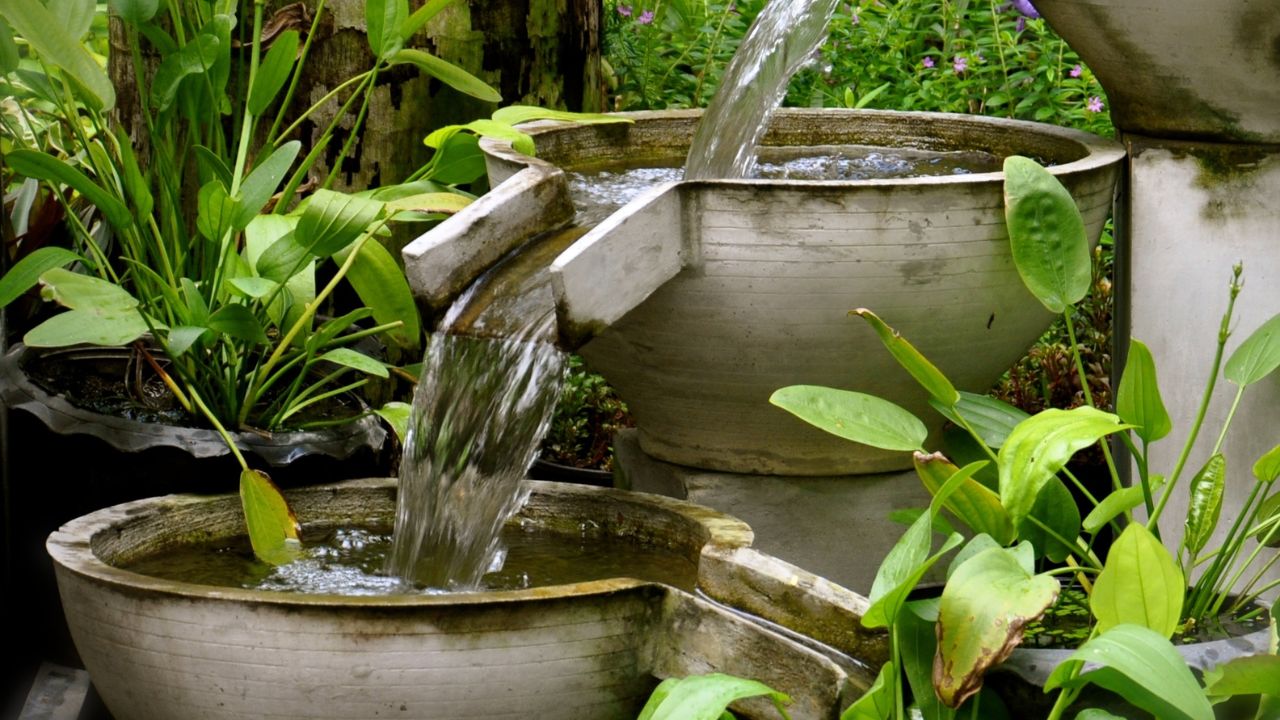
Image Credit: Shutterstock.
Fountains create shimmering patterns of sunlight as they capture the sun. Moving water features with fountains generate soothing sounds that attract migrating birds. And there is a type of fountain that is right for just about every garden design.
To decide which fountain is right for you, you need to consider not just sound, size, and style, but the plants you want to grow around it. Fountains of all styles come in two basic types:
- spray fountains, which are just water nozzles that spray water in various patterns
- statuary fountains, which spray water from a statue or some other figure
The more formal your landscape, the more elaborate the spray pattern. A fountain statue in front of an arbor of climbing roses, clematis, or bougainvillea (check out how to fertilize bougainvillea), if you have enough sun, may look great in a formal garden. But if you want to maintain a wild, rustic look in your landscape, a simple geyser fountain, maybe framed by paving stones, or even a fountain that appears to be bubbling up from the ground may be the best compliment to your landscape.
6 Simple Tips for Landscaping Around Water Fountains
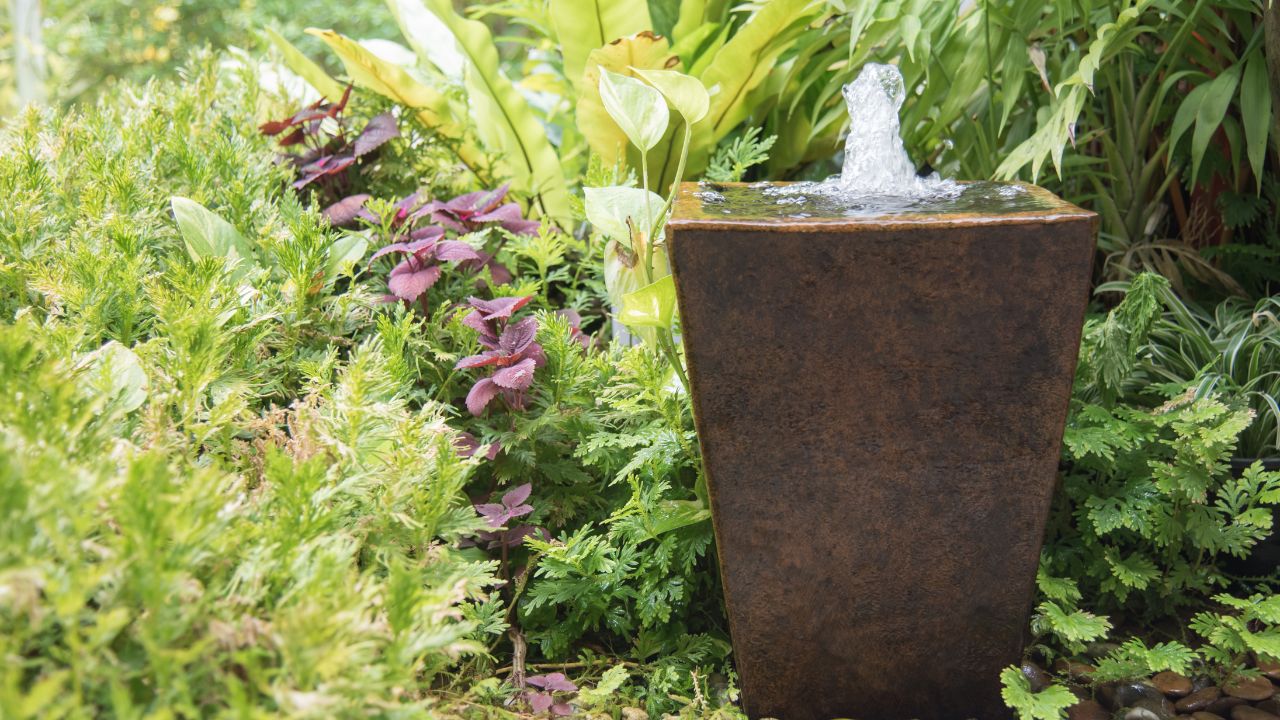
Image Credit: Shutterstock.
Once you have chosen the perfect site for the perfect water fountain to fit your existing landscape, there are relatively small projects that can make it even more attractive.
1. Decorate the base of your fountain with stone or gravel
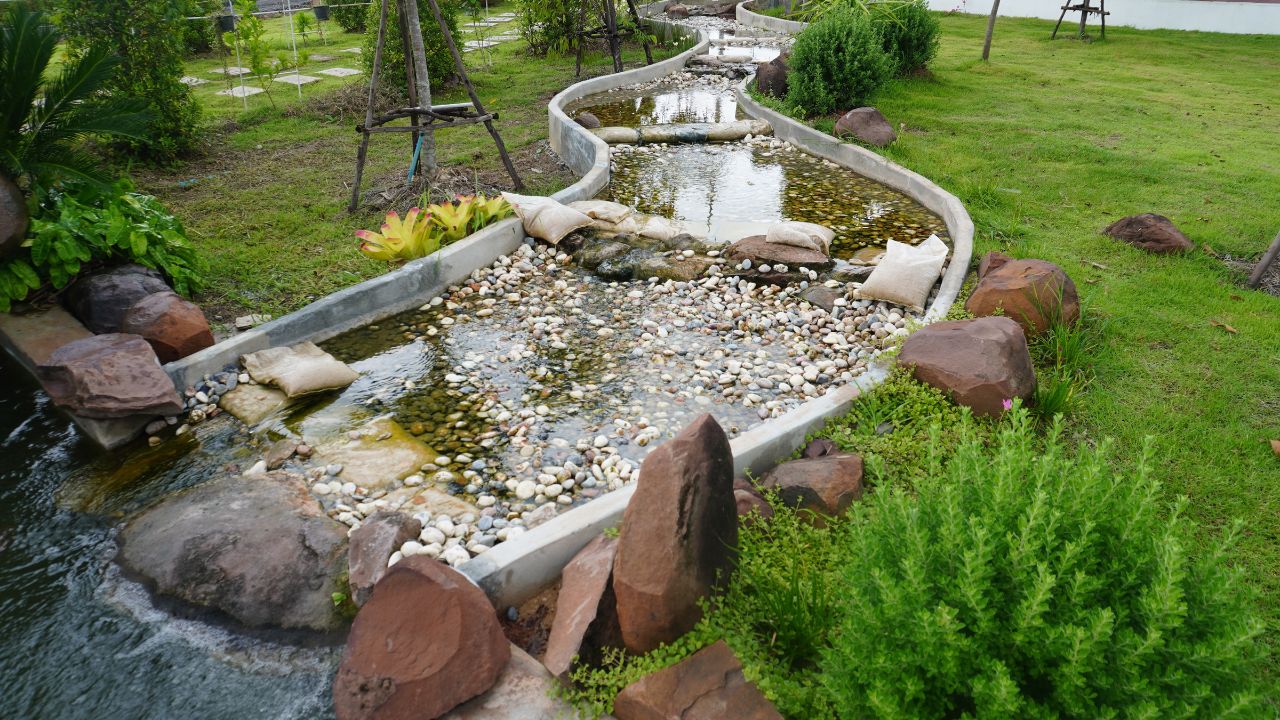
Image Credit: Shutterstock.
Depending on your landscape design and the rest of your yard, you can choose a variety of materials to accent the base. Gravel and river stones add interesting textures around your fountain. Paving stones work equally well in modern and rustic landscapes as accents for your fountain.
If you live near the coast, crushed oyster shells or seashells may help your fountain blend in with the rest of your yard. Just be sure to keep decorative materials from spilling into the collection pond for your fountain by creating a border or rim around any ground-level collection pool.
Metal edging, plastic edging, pavers, stone, and brick all work to keep ornamental edging in place.
2. Consider colored lenses for general lighting

Image Credit: Shutterstock.
The right color lenses for nighttime illumination can bring out the beauty of statuary while using the shapes and textures of your landscape plants to frame your fountain. But be sure not to choose colors that clash with flowers or variegated leaves.
3. Use vines to cover fixtures
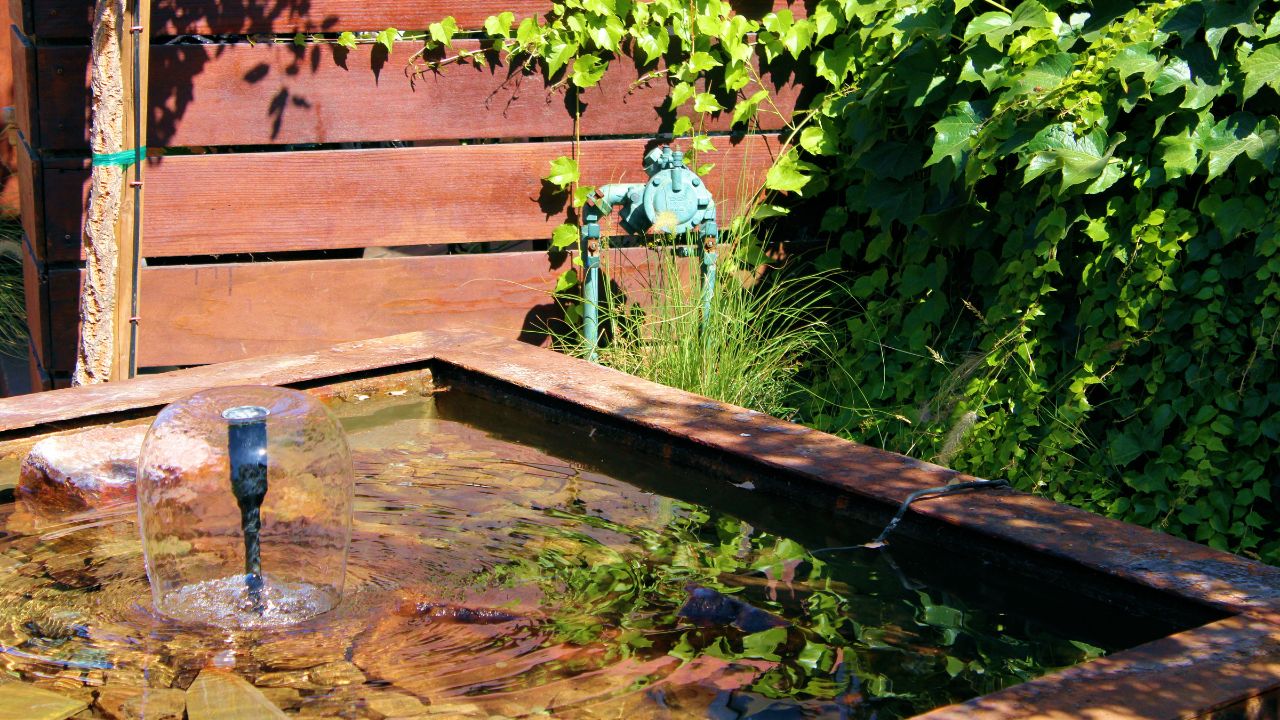
Image Credit: Shutterstock.
Wall fountains need pipes for recirculating water. Recirculating fountains require pumps and electrical connections. Hardware for your fountain is usually less noticeable if it is painted dark green. It may not be noticeable at all if it is covered with vines.
4. Be careful about the placement of underwater lights
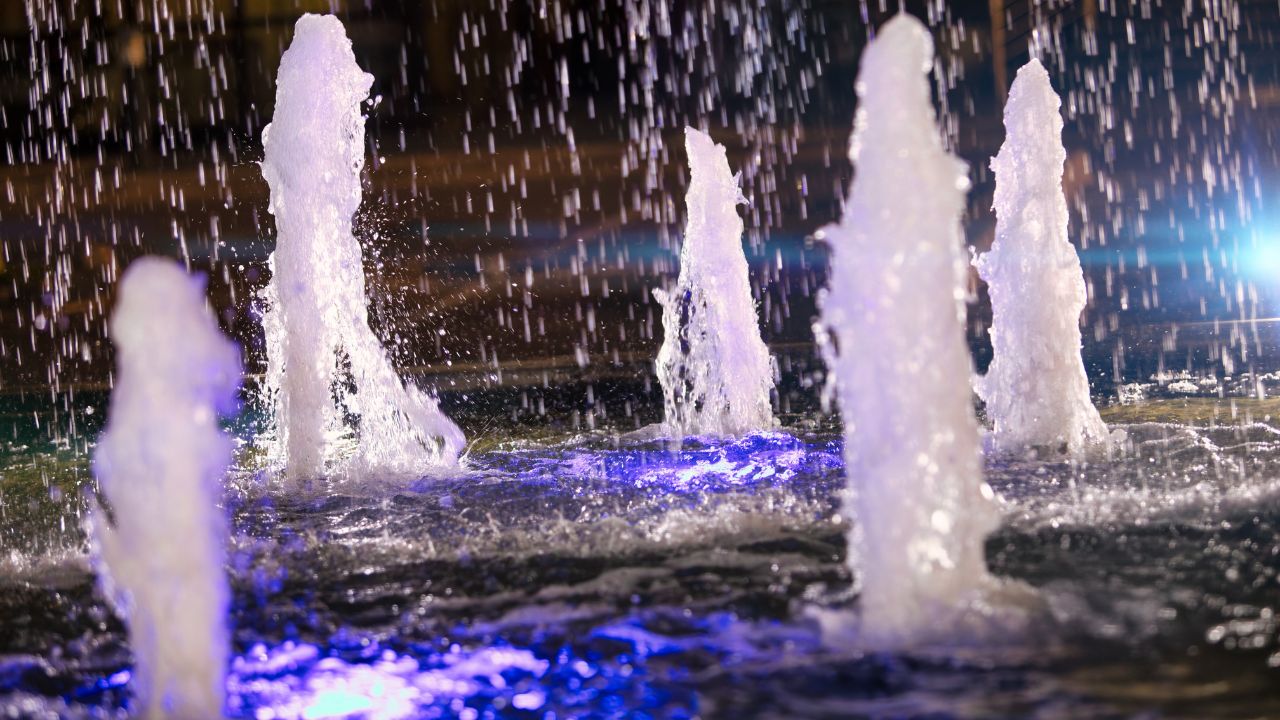
Image Credit: Shutterstock.
Underwater lights can highlight waterfalls, lily ponds, and other features. But do not place them where they cause glare or they block the reflection of the moon on a moonlit night.
Add color to refresh old fountains before investing in landscaping around them. If you have a statuary fountain or a concrete fountain that is beginning to look drab, add color to freshen it up before you change the landscaping around it. Choose a bold, bright shade and use it to paint the entire fountain.
Don’t forget to use a concrete primer before painting with masonry paint, designed to stand up to constant moisture. Bold color around the rim of your fountain catches the eye so you may not need to spend as much time working on landscape plants.
5. Float ornaments
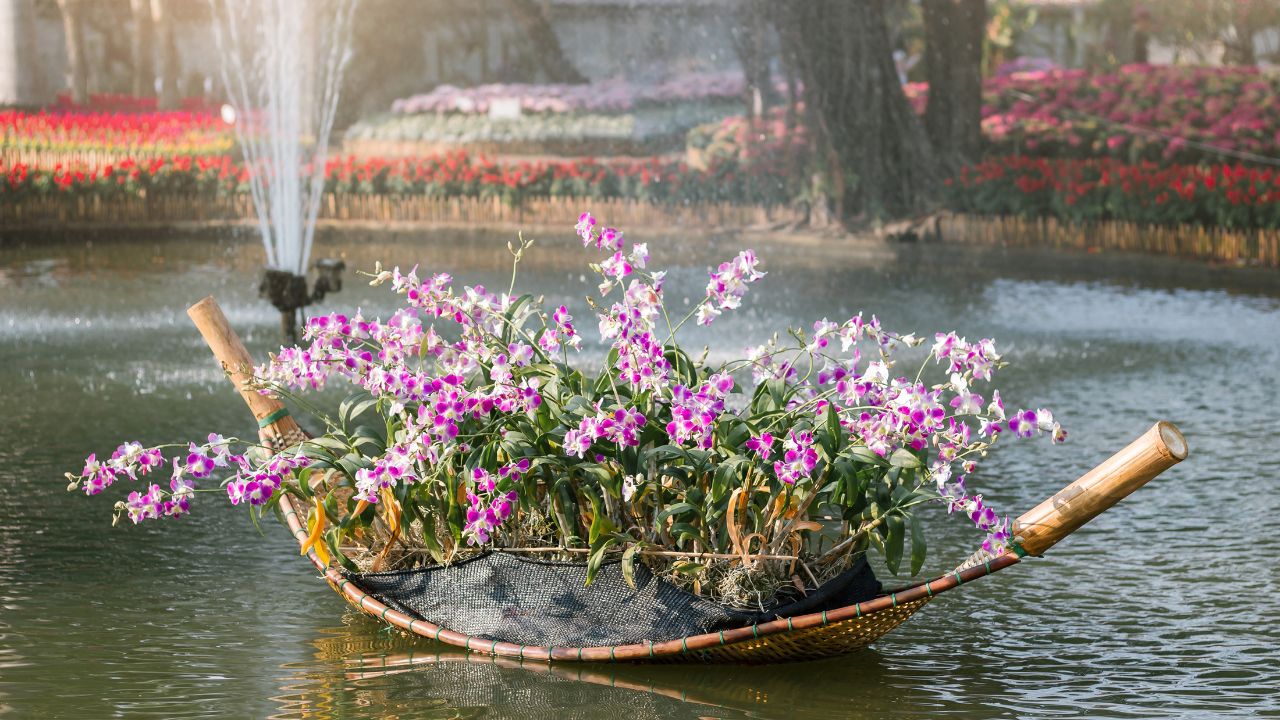
Image Credit: Shutterstock.
Depending on the height of your fountain and its reservoir, floating ornaments can draw attention to your fountain in a subtle way. In larger fountains, Japanese fishing net floats with their colored glass create a colorful, shimmering effect that draws the eye to the fountain.
6. Pair your fountain with plants

Image Credit: Shutterstock.
If you have a freestanding fountain, plant a ground cover around the base. Dichondra argentea” Silver Falls,” also known as silver nickel vine, provides tiny silvery-green leaves for a delicate effect.
In addition to the climbing roses and flowering vines mentioned above, Thunbergia alata, also known as black-eyed Susan vine, produces yellow flowers with purple centers that accent many kinds of fountain statuary.

